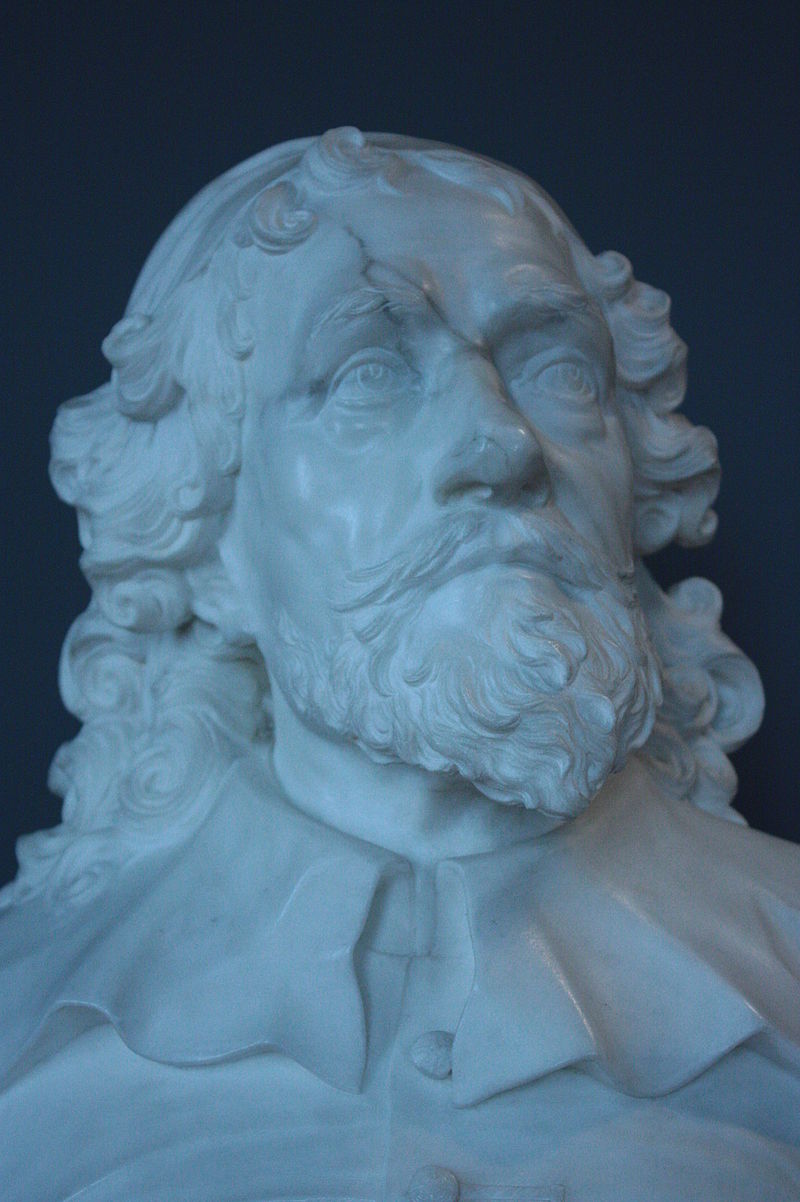Inigo Jones
Bust of Inigo Jones by John Michael Rysbrack, 1725
Little is known about Jones's early years, beyond the fact that he was born 15 July 1573, at Smithfield, London, the son of Inigo Jones, a Welsh cloth worker and baptised at the church of St Bartholomew.
Inigo is often called the first English architect. Jones's first recorded architectural design is for a monument to Lady Cotton, circa 1608, at Norton-in-Hales, Shropshire showing early signs of his classical intentions. Around this time, Jones also produced drawings for the New Exchange in the Strand and the central tower of St. Paul's Cathedral,
The fancy taste in buildings reached London about 1615, whilst much of England was still half-medieval. Its arrival in London had been expected. as taste in other things such as poetry, art, music and the stage was already reaching far beyond what had been experienced before.
This modern culture had already been discovered by travellers to Italy, in places like Florence, Milan and Venice by people interested in such things. There was talk about
the possibilities of real Italian buildings being built in England. Sooner or later it was bound to happen. All that was needed was the right person with the right opportunists to make it happen, which it did in 1615, the year that Inigo Jones arrived back from his second visit to Italy, the same year he became Surveyor to the King.
The freshness of Jones's work in Jacobean London cannot be over-stressed. It is in no way exaggerating to say that Jones's architecture influence did not get appreciated until nearly a century after his
most important works were completed.
Queen's House
 The Queen's House, just as delightful inside as outside
The Queen's House, just as delightful inside as outside

Inigo Jones, early commission, for Anne of Denmark, the Queen of King James I. Queen's House is one of the most important buildings in British architectural history, being the first consciously classical building to have been constructed in the country. It was one of Jones's major commission after returning from his 1613Ė1615 grand tour of Roman, Renaissance, and Palladian architecture in Italy.
The first of his chief buildings, the Whitehall Banqueting House, with a ceiling by Rubens, was begun in 1619 and completed in 1622. It is the only survivor of the Whitehall Palace, which was destroyed by fire in 1698 and demolished the same year.

Banqueting House, the only survivor of the Whitehall Palace
The fire which started on 4 January 1698, was started inadvertently by a servant who had hung wet linen by a charcoal brazier to dry.
The cloths caught fire which raged for 15 hours before it was extinguished. The next day the wind picked up and re-ignited the fire. Christopher Wren, the then King's Surveyor of Works, was ordered to focus manpower on
the architectural jewel of the palace, Banqueting House, which was saved by Wren's bricklayers blocking up the main windows.
The Banqueting House was used to stage the execution of King Charles I, who was beheaded on 30th January 1649, on scaffolding erected outside the building, where Charles was led from Banqueting House through a centre window leading to the scaffold. In remembrance of this there is a cast head just above the main door.

St Paul's, Covent Garden, the finest barn in Europe
The other project in which Jones was involved is the design of Covent Garden square. He was commissioned by the Earl of Bedford to build a residential square, which he did along the lines of the Italian piazza of Livorno. It is the first regularly planned square in London. The Earl felt obliged to provide a church and he warned Jones that he wanted to economise. He told him to simply erect a "barn" and Jones's oft-quoted response was that his lordship would have "the finest barn in Europe". In the design of St Paul's, Jones faithfully adhered to Vitruvius's design for a Tuscan temple and it was the first wholly and authentically classical church built in England. The inside of St Paul's, Covent Garden was gutted by fire in 1795, but externally it remains much as Jones designed it and dominates the west side of the piazza.

The Church of St Benet, where Inigo Jones is buried with his parents
Inigo Jones had been allowed lodgings in Somerset House, where he died shortly before his 79th birthday in 1652. He was buried with his parents in the church of St. Benet Paulís Wharf.
The Church of St Benet, sometimes spelt as St Bennetís, and derived of course from St Benedictís, is today the City's Welsh Church. It stands just to the side of Queen Victoria Street, towards Upper Thames Street, and is a work of Christopher Wren, replacing a medieval church destroyed in the Great Fire of London in 1666. Some remnants of the walls apparently survive in the core of the current building, which was put up between 1677 and 1685. Jones left funds in his will for a monument, but both church and monument were destroyed in the Great Fire of 1666.

This house in Great St Helen's is said to have been built by Jones
London Time

Follow Us
The contents of this website are the property of knowledgeoflondon.com and therefore must not be reproduced without permission. Every effort is made to ensure the details contained on this website are correct, however, we cannot accept responsibility for errors and omissions.
© Copyright 2004 -
Contact Us | Advertise